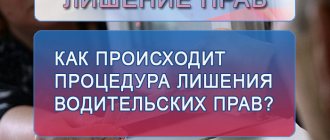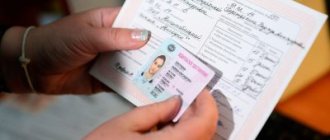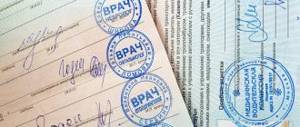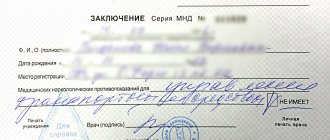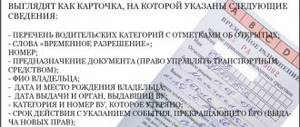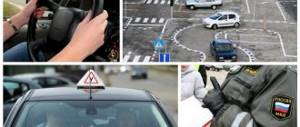According to Art. 3.8. The Code of Administrative Offenses, the current administrative legislation provides for such a measure of punishment for violators of traffic rules as the revocation of a special right. A driver’s license can be deprived only for serious or systematic violations of traffic rules and only in cases where the corresponding sanction is provided for by one of the articles of the Special Part of the Code of Administrative Offenses of the Russian Federation (that is, one of the articles of Chapters 5 - 21 of the Code of Administrative Offenses of the Russian Federation, for more details, see the picture). For example, for driving while intoxicated (Part 1, Article 12.8.), for leaving a railway crossing with a closed barrier (Part 1, Article 12.10.), for overtaking through continuous markings (Part 4, Article 12.15. ).
What is a petition for non-revocation of a driver's license?
A petition (hereinafter also referred to as a petition) for the non-application of such a sanction as deprivation of a driver’s license is understood as a written document submitted to the court by a citizen held accountable, containing a request to impose another punishment, regulated by the relevant article of the Special Part of the Code of Administrative Offences, indicating specific reasons and the circumstances supporting this request.
Attention! If you have any questions, you can chat for free with a lawyer at the bottom of the screen or call Moscow; Saint Petersburg; Free call for all of Russia.
Filing a petition for non-deprivation of a driver's license makes sense only if the case of an administrative violation is considered by the court. This is possible in two cases:
- if only the court has the authority to impose punishment for the relevant violation;
- or if the traffic police inspector has transferred the case materials for consideration to a judicial authority (below is a list of violations for which the inspector himself chooses - either to impose a punishment “on the spot”, or to transfer the case materials for consideration to the court).
In other cases, filing a petition for non-deprivation of a driver’s license does not make sense. Justification – in accordance with Art. 3.8. Code of Administrative Offenses, only a court can deprive rights. Therefore, if the justice body cannot consider a case of violation at all (see below for a list of such offenses), then under no circumstances can they confiscate the driving license.
That is, for such violations, as a rule, punishment is established either in the form of a warning or in the form of a fine and, on the basis of stat. 28.6. Code of Administrative Offences, the inspector in these cases simply draws up a resolution (without a protocol), hands over a copy with payment details and releases the driver.
What it is?
Who submits a request from the place of work?
The request may be submitted by the manager at the offender’s place of employment. Sometimes there are situations in which an organization may suffer losses due to the deprivation of the rights of one of its employees. For example, if it concerns a transport company. Then the manager submits the petition.
If other employees or management intervene on behalf of the motorist who violated the law, the punishment may be reduced (provided that there are no aggravating circumstances). In this case, in addition to the application, a positive reference from the place of work is attached. It is important to point out that the driver’s work is directly related to transport management; the suspension of such an employee from driving will greatly affect the financial position of the company.
The document must contain information: on whose behalf it is drawn up and to whom it is intended. The body of the petition describes:
- request to mitigate the punishment and not deprive the driver of his license;
- the circumstances that determine such a request are indicated;
- list the positive qualities of the driver that characterize him as a responsible and law-abiding citizen.
If the court takes into account all the details, there is a high probability that the request will be granted.
Contents of the petition to the traffic police
The petition includes two important sections:
- Please do not apply punishment in the form of deprivation of driver's license.
- Providing objective evidence in favor of the offender, on the basis of which the penalty could be cancelled.
Who is eligible to apply?
- The driver himself.
- Representative of the interests of the violator.
- The petition can be drawn up on behalf of close relatives, friends or colleagues who decided to provide assistance with this problem.
- An employer can file a petition if the organization risks incurring losses due to deprivation of an employee’s rights.
- The head of the educational institution where the offender is studying can also intercede.
It is best to prepare and submit such a petition as early as possible, at the initial stages of consideration of the administrative case. It is sent to the head of the traffic police unit at the time of the preliminary investigation. Before transferring the case to a magistrate, the State Traffic Inspectorate determines whether it is necessary to deprive the driver of the right to drive a car or apply a lighter punishment. In the latter case, the case is not referred to the court, the punishment is limited to a fine.
Appeal to the World Court
A petition to the court not to deprive of rights must contain significant arguments in favor of the driver that can convince the magistrate to mitigate the punishment or cancel it completely.
It makes sense to submit such a document to the court only when sanctions for an administrative violation also provide for other methods of punishment. If the legislation for an offense defines punishment exclusively in the form of deprivation of rights, then after considering the petition, the court may order deprivation of the VP for a short period.
A petition is sent to the court at the time the case is transferred from the State Traffic Inspectorate or during the consideration of the court case. If a court decision has already been made, it can be appealed within 10 days.
What circumstances will help in the consideration?
- The case is being considered after the statute of limitations has expired.
- Significant deterioration in the quality of life of the driver or those who depend on him due to deprivation of his license.
- Removal from the regulations for medical examination of a person for alcohol intoxication.
- Refusal to consider the testimony of witnesses in a case for unfounded reasons. In addition, you need to refer to mitigating circumstances, if any (in accordance with Article 4.2 of the Administrative Code).
Normative base
The regulatory framework for filing a petition for non-deprivation of a driver’s license consists of the following articles of the Administrative Code:
| Link to article, part, paragraph of the Code of Administrative Offenses | A comment |
| Part 1 stat. 24.4., as well as part 1 stat. 25.1. | It says that the violator can file petitions, and they must be considered by the court. |
| Part 2 stat. 24.4. | It is indicated that petitions must be made in writing. The court will consider them immediately upon receipt. |
| Clause 6 stat. 29.1. | It is said that the judge, when preparing to consider the case, must check whether there are any submitted petitions and challenges. |
| Part 2 stat. 29.6. | It is said that the judge may extend the established two-month period for consideration of the case if any petitions are received from the participants in the process for non-deprivation of a driver’s license. |
Who makes the decision
The decision can be made by different authorities, depending on where and to whom the petition was sent. If the petition was addressed to the traffic police, then the decision, either positive or negative, is made by the head of the traffic police department or the traffic police commission. If a document is submitted to the court in the name of a judge, the decision is made only by the court. If a petition is rejected, the authority that issued the verdict must provide arguments and reasons for the refusal in writing.
When filing a petition directly during a court hearing, it is also not advisable, because the court is obliged to consider in detail all the evidence presented in the petition. There is no time left for this during the process and such a document is more likely to be rejected.
Lawyers often advise submitting during a hearing not a petition, but an explanatory note; this is a kind of trick, since the circumstances set out in it, essentially evidence, cannot be rejected. This means they will be involved in the case. This note sets out the reasons for violating the rules, may include documents mitigating the guilt, and a request to replace the punishment with a fine. In terms of content, such a note is the same as a petition, but cannot be rejected.
If the traffic police rejected the petition, the court will most likely side with the traffic police. And you need to submit an even more complete petition to the court, with other compelling documents indicating that the driver needs a license, and the traffic violation occurred for reasons beyond his control.
Reasons for the need to submit a petition for non-deprivation of a driver’s license
A petition for non-revocation of a driver's license must be submitted only if the following are not disputed:
- the very fact of committing an administrative offense;
- actions of traffic police officials when recording a violation and drawing up a protocol;
- the presence of guilt of the citizen held accountable.
In other words, this petition is submitted if the driver agrees that he actually violated the traffic rules, but for one reason or another does not want to be punished in the form of revocation of the driving license.
For example, if activities related to driving a car are the main and only source of income, then deprivation of a driver’s license will put the driver in a difficult financial situation.
There may be other reasons for filing a petition, which are indicated in Part 2 of Art. 4.1. Code of Administrative Offenses, for example:
- property status of the perpetrator;
- the nature of the offense committed;
- the identity of the offender;
- the presence of circumstances mitigating liability.
Who can file a petition for non-deprivation of driving privileges?
The document may be written and submitted by the following persons and organizations:
- A car owner who is facing deprivation of his right to drive a car.
- The representative of the offender , who is most often represented by lawyers involved in auto cases.
- His relatives , acquaintances or friends
- Neighbors, co-workers or other citizens who belong to the so-called. public
- The enterprise where the offender works . Most often this happens if the employer is interested in the employee retaining his rights or the offense occurred on a company vehicle.
- The dean or rector of the educational institution , if deprivation of rights threatens a full-time student.
If the petition is written from an enterprise or educational institution, then it must meet the following requirements:
- A special form of the enterprise or educational institution is used, if available.
- The document must be signed by the head of the organization.
- There must be a seal of the institution on the document.
There have been cases when, at the stage of consideration of a case in the magistrate's court, a petition from an enterprise was rejected due to the fact that it did not have the signature of the head or the seal of the organization. The employer’s office explained to the offender that the manager’s seal and signature are supposedly placed only on documents requested by the court.
A petition is a request, and no court will require such a document. To avoid getting into a similar situation, if the enterprise does not certify the petition with a signature and seal, citing any reasons, then it is better to write a petition on your own behalf or ask relatives, friends or other persons.
At what stage is a petition for non-deprivation of a driver's license submitted?
In Art. 24.4. The Code of Administrative Offenses does not say at what stage petitions should be submitted.
Judging from the meaning of the totality of regulatory provisions of the Code of Administrative Offenses, filing a petition for non-deprivation of a driver’s license can be done:
- starting from the moment the traffic police inspector fulfilled the obligation provided for in Part 1 of Art. 28.8. Code of Administrative Offenses - that is, transferred the case materials to the judge for consideration;
- and ending with the moment when the judge announces the decision on the case (Part 1 of Article 29.11.).
It is recommended not to delay and to submit an application for non-deprivation of a driver’s license while preparing for the consideration (clause 6 of Article 29.1.).
Rules for filling out an application for non-deprivation of a driver's license
The current administrative regulations do not regulate exactly how applications should be filled out. It only says that requests must be made in writing.
This means that there is no unified form. Therefore, it is recommended that a traffic violator draw up a petition for non-deprivation of a driver’s license on the basis of the rules that have developed and are applied in business practice when filing such applications.
The portal’s specialists have developed step-by-step instructions for filling out an application for non-deprivation of a driver’s license based on business rules:
- take a standard A4 sheet;
- we decide how exactly we will fill it out - by hand or using typewritten (computer) technology;
- we draw up a “header” in which we indicate the name of the court where the document is being submitted, the full name of the person held accountable, and the number of the administrative case pending in this court;
- in the center we write the name of the document - that is, “Application for non-deprivation of a driver’s license”;
- further we describe the situation in detail - the date, time of the violation, its essence, link to the paragraph, part, article of the Code of Administrative Offenses, full name of the traffic police inspector who recorded the offense, details of the state registration plate, details of the drawn up protocol, make and model of the car and other data;
- then we write a clear agreement with the charges brought, that is, there is no need to dispute the very fact of the violation, the actions of the traffic police officers, etc.;
- We indicate a list of reasons due to which the driver should not be deprived of his license (for example, the presence of several young children, a difficult financial situation, an indication that the car is the main source of income, etc.);
- then in the center we put the word “I ask” and write a request to the court not to deprive the driver of the right to license, but to impose such and such a punishment (for example, administrative arrest);
- Finally, we enter the date of the application, signature and transcript.
You can ask for such and such a punishment if it is provided for in the relevant article. For example, for leaving the scene of an accident in accordance with Part 2 of Art. 12.27. provided:
- or deprivation of rights from 1 to 1.5 years;
- or administrative arrest for up to 15 days.
Accordingly, in this case it is necessary to apply for an arrest.
Or, for example, you can apply to replace the deprivation with an administrative fine (see, for example, Part 1 and Part 2 of Article 12.24 of the Administrative Code).
Extenuating circumstances
The law also provides for mitigating circumstances that can save the driver from being deprived of his right to drive a car.
Typically, mitigating circumstances that are considered are:
- Minors, disabled people who are dependent on the offender.
- Driving is the only source of income.
- No overdue fines or other penalties.
- Photo, video evidence indicating the driver’s complete or partial innocence.
Sample of filling out an application for non-deprivation of a driver's license
The portal's lawyers have developed a sample application form for non-deprivation of a driver's license in WORD format. All you need to do is enter the required data in the appropriate fields (an explanation of what exactly needs to be written is indicated below these fields), and then print.
Institutions for filing a petition for non-deprivation of a driver's license
In accordance with the last paragraph of Part 3 of Art. 23.1. Administrative Code, most cases related to traffic violations are considered by magistrates. Only in certain cases can a case be referred for consideration:
- district court (for example, if an employee of the Investigative Committee violated traffic rules - paragraph 2, part 3, article 23.1 of the Administrative Code);
- arbitration court (see paragraph 4 and paragraph 5 of part 3 of article 23.1 of the Administrative Code).
As for geographical and territorial jurisdiction, the case is considered (in general) at the place where the offense was committed (Part 1 of Article 29.5 of the Administrative Code). But if the violator submits a corresponding petition, they may also consider the driver at the place of residence.
Required documents for filing an application
The application for non-deprivation of a driver's license must be accompanied by documents that confirm the circumstances listed by the violator in the text of the document, according to which it is better to replace the deprivation with another type of administrative punishment.
Of course, a unified package of documents has not been approved, since it will vary depending on the specific case and circumstances. Here is an approximate list of necessary documents for filing a petition for non-deprivation of a driver’s license:
- a copy of the offender’s passport;
- a copy of the violation protocol drawn up in accordance with Art. 28.2.Administrative Code;
- characteristics from the place of work, study, residence, signed, respectively, by the head of the production, educational organization or housemates;
- certificates from medical organizations confirming the presence of relatives with serious illnesses and requiring constant care;
- documents confirming the presence of mitigating circumstances (for example, a certificate of pregnancy or a woman has a young child - clause 10, part 1, article 4.2 of the Administrative Code);
- papers certifying the compensation for damage caused by an offense (for example, about voluntary payment of moral damages in favor of a hit pedestrian - stat. 12.24. Code of Administrative Offences);
- other documents that, in the opinion of the offender, may prompt the court to make a decision not to impose deprivation of rights, but another punishment provided for in the relevant article.
How to write a document correctly
The law does not provide a special form for writing a petition. You will not find a form for drawing up a petition. The document is written in free form, however, in order to be considered, it must clearly state all the information on the case under consideration and clearly state your request.
An approximate outline of the document is as follows:
- Name of the organization and full name of the head of the traffic police department or judge (depending on which organization the petition is submitted to).
- Information on the violation in question (when, where and at what time the offense was committed, details of the department employee who compiled the protocol, the article of the Code of Administrative Offenses under which the violation is qualified, the circumstances of the incident and the grounds for mitigation of punishment).
- The reason why the petition is being submitted (for example, the violator works as a driver and deprivation of rights will be followed by loss of his job, the car is a means of transportation for a citizen with a disability and other reasons).
- A clearly formulated request for a replacement (for example, “I ask you to replace the measure of liability in the form of deprivation of rights with a fine”).
- List of documents that substantiate the applicant’s request and are attached to the application.
- Signature and date of submission of the document.
Attention! You should not include your own, unsubstantiated, conclusions and assumptions in the petition. You should not give recommendations to the head of the traffic police department or judges. It can only refer to the law that substantiates your request.
What circumstances are considered mitigating by law?
When drawing up a petition, you can point out a number of circumstances that will definitely be regarded as mitigating when making a decision at any stage. These include:
- Admission of guilt and repentance.
- Providing assistance to the authorized body in clarifying the circumstances of the offense committed.
- Voluntary compensation for damage caused by a violation.
- Commitment of a violation by a woman - a pregnant woman or a mother with a young child.
There is also a clause about committing an offense in a state of strong emotional disturbance caused by life or family circumstances.
Drivers are also very fond of referring to it, however, it is worth knowing that this point should not be applied in a situation with a violation of traffic rules, since, being in such emotional agitation, you have no right to get behind the wheel. The entire list of circumstances that may be considered mitigating can be found in Art. 4.2 Code of Administrative Offenses of the Russian Federation.
What documents should be prepared and attached to the application?
The request contained in the document should not be unfounded; it should be supported by documents. To prove the grounds for mitigation of punishment given in the petition, you can attach the following documents:
- A positive reference from the employer or from the dean’s office of the educational organization.
- A certificate from a drug treatment or psychiatric medical institution confirming that the applicant is not registered there.
- Photos or video materials , which can confirm that the violation was accidental and provoked by certain factors. It's even better if you can prove that you were forced to do just that. I will discuss this evidence below.
- Copies of the birth certificate of your dependent children.
- Copies of pension certificates of elderly parents or documents confirming the disability of your family members for whose transportation the car is used.
- Documents certifying that the applicant is unemployed, a pensioner or the sole breadwinner , for example, if the wife does not work or is on maternity leave.
- A certificate from the traffic police , which can confirm that your entire driving history of the car was not tainted by accidents (if the offense was committed for the first time).
- Other documents that can mitigate punishment.
Step-by-step instructions for filing a petition
The entire procedure from stopping the car by a traffic police inspector, recording the offense and until the final decision is made is as follows:
- initiation of a case (Article 28.1 of the Administrative Code);
- drawing up a protocol by the traffic police official who recorded the offense (Article 28.2.) (this is done immediately after the violation is detected - Part 1 of Article 28.5.);
- handing over a copy of the protocol to the violator;
- sending the protocol for consideration to a judge within 3 days (Part 1 of Article 28.8.);
- submission by the violator of a written petition for non-deprivation of a driver’s license (for how to draw up samples, see above in the article) to the magistrate’s court located at the place where the violation was committed (or at the driver’s place of residence, if a corresponding petition was submitted);
- if the petition is rejected, a ruling is issued; if it is not rejected, then the ruling is not issued (Part 2 of Article 24.4.).
Regardless of whether the application for non-deprivation of a driver’s license is rejected or not rejected, the consideration of the case will be carried out in the general manner and within the time limits specified in Chapter 29 of the Code of Administrative Offenses, that is:
- preparation for consideration is being carried out (stat. 29.1.);
- the circumstances preventing the consideration of the case by the appointed judge are checked (Article 29.2.);
- a date and time are set for the meeting;
- Testimony of the offender, witnesses, and other persons participating in the process is heard (Part 2 of Article 29.7.);
- a date and time are set for the announcement of the decision on the case (the decision can be in one of two types - either on the imposition of punishment or on release from liability - Part 1 of Article 29.9.).
Will I be satisfied or denied?
It depends on what exactly you are asking for, how and on what basis. But there are general rules. Refusal is only possible if motivated - that is, if a judge or inspector refuses to satisfy a request, they must legally explain why. If you ask for what the law provides you with, then they cannot refuse you.
In addition, depending on the types of “moves” there is a different probability of satisfaction:
- requests for legal assistance are rarely denied, since this possibility is prescribed by the Constitution, and employees are severely punished for violating it,
- if you ask to consider the case at your place of residence, then they may refuse, citing the fact that transferring the case to another city, district, region, and so on will interfere with a comprehensive study of the materials,
- when “moving” to impose a minimum sentence, replacing one sanction with another within the norms of the Code of Administrative Offenses of the Russian Federation, or issuing an oral remark, everything depends on the factors prescribed in the legislation and established judicial practice May 20, 2021,
- the situation is similar when applying for the restoration of the discount period on the fine - if you actually received a letter with a traffic police fine after 20 days from the date of the decision, then satisfaction will not be denied,
- nor has the right to refuse to admit your evidence or attract witnesses.
Decision-making
After the expiration of the established two-month period (Part 1.1. Stat. 29.6. Code of Administrative Offenses), the court makes a decision (except for cases where the period was extended in accordance with Part 2 of Stat. 29.6.).
If the court decided to impose a punishment (that is, the guilt of the offender was established), then the decision will indicate a reasoned decision in the case (clause 6, part 1, article 29.10.).
The traffic violator will learn that the request not to revoke his driver’s license was granted only when the final verdict is announced. Of course, the court will also indicate in its ruling what it was specifically guided by when deciding to deprive of rights or impose another punishment.
Note that the court makes a decision in accordance with the general rules for imposing sanctions specified in Art. 4.1. Code of Administrative Offences. That is, the petition of the violator is not the only circumstance that entails the possibility of imposing one or another sanction. This petition may not be filed, but the court will rule on non-deprivation. The opposite is also true - the petition was granted, but the court did not take it into account and nevertheless ordered the revocation of the license (for example, if the arguments stated by the violator are insignificant or are not supported by relevant evidence).
What documents are required
Documents must be submitted in both originals and copies.
Any documents that can confirm the need to mitigate guilt are attached, such as:
- Certificate of accident-free driving from the traffic police.
- Birth certificates, proof of disability of dependents.
- A document proving that the offender is the only breadwinner in the family.
- A certificate from a narcologist stating that he is not registered.
- Statements from witnesses to the incident, if they mitigate guilt.
- A petition for commutation of punishment, in fact, a petition itself.
Nuances
When filing a petition for non-deprivation of a driver’s license, the driver should take into account some nuances:
- if the relevant article of the Code of Administrative Offenses provides for unalternative deprivation of rights (for example, when overtaking repeatedly through a continuous line - Part 5 of Article 12.15.), then it makes no sense to submit a request for non-deprivation - it is the very fact of the violation that should be challenged, that is, to prove innocence;
- in the cases specified in Part 2 of Art. 23.1., the inspector himself decides whether to transfer the case to court or impose a fine on the spot - accordingly, a kind of “petition” that he does not transfer the case materials to the court should be submitted to the inspector (in other words, ask him to impose a fine);
- sending the case to court in accordance with Art. 28.8. does not mean that the justice authority will impose deprivation of driving license (for example, an article of the Code of Administrative Offenses provides for either a fine or deprivation of a driver’s license, but the inspector decides not to impose a fine, but to send the case to court, this does not mean that the court will now specifically impose deprivation - quite possibly a fine);
- if the petition for non-deprivation did not help, and the driver’s driving license was nevertheless revoked, all is not lost - the court’s decision can be appealed in the standard manner provided for by Chapter 30 of the Code of Administrative Offences.
Why is an application necessary?
To understand the big picture, you need to know what it is.
A petition is a request addressed to the court or a certain official to mitigate the penalty.
Your driver's license can be revoked for the following offenses:
- Drunk driving.
- Drifting into oncoming traffic.
- Crossing a double solid line.
- Completing the maneuver, overtaking through a double solid line.
- Leaving the scene of an accident.
- Overtaking, in the area of effect of a maneuver prohibition sign.
- Driving a disabled vehicle.
- Driving without a driver's license.
- Previously unpaid fines.
- Driving within the area covered by the “brick” sign.
- Exceeding the speed limit by more than 60 km/h.
But by filing a petition with the court or the traffic police, you can mitigate the penalty. The document does not have a specific template or form and is written in free form.
You can submit it both at the stage of consideration of the case in the traffic police, and directly to the court. But it should be remembered that the purpose of the petition is not to pity the judge or employee considering the case, but to state the facts, independent of the driver, that prompted him to commit a violation.
The document can be submitted both to the traffic police at the stage of consideration of the case of an offense, and to the court. Even if the driver or his legal representatives sent a petition to the traffic police and it was rejected, the applicant has the right to submit the document again in his name, but new facts mitigating the applicant’s guilt must be indicated there.
It is worth saying that when a request to the traffic police is rejected, the court most often makes a decision without change. Therefore, the evidence must be serious and factual.
If the application is considered favorably, the measure of deprivation of a driver's license may be replaced by a fine.
